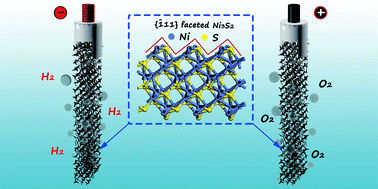Tailoring the facets of Ni3S2 as a bifunctional electrocatalyst for high-performance overall water-splitting†
Abstract
Tailoring crystallographic facets is one of the most effective ways to design promising electrocatalytic materials. Herein, for the first time, the asymmetric zigzag structure of {![[1 with combining macron]](https://www.rsc.org/images/entities/char_0031_0304.gif) 11} faceted Ni3S2 is elucidated, which is predicted by DFT calculation to have high electrocatalytic activity for both the hydrogen evolution reaction and oxygen evolution reaction. Such Ni3S2 nanostructures are then in situ fabricated on a robust 3D scaffold via a one-step hydrothermal treatment of porous Ni foam in a Na2S aqueous solution, which effectively avoids the hydrogen brittleness of the Ni foam skeletons and guarantees the robustness of the 3D scaffold. As expected, the as-prepared Ni3S2 exhibits appealing catalytic performance for both the hydrogen evolution reaction (η = 189 mV at j = 10 mA cm−2 with a Tafel slope of 89.3 mV dec−1) and oxygen evolution reaction (η = 296 mV at j = 10 mA cm−2 with a Tafel slope of 65.1 mV dec−1), which is comparable to that of the commercial noble-metal-based catalyst Pt/C and better than that of the commercial catalyst IrO2. The self-supported Ni3S2 electrodes are further used for overall water-splitting, demonstrating high efficiency and durable stability. This work will provide new insights for tailoring crystallographic facets and fabricating advanced energy materials.
11} faceted Ni3S2 is elucidated, which is predicted by DFT calculation to have high electrocatalytic activity for both the hydrogen evolution reaction and oxygen evolution reaction. Such Ni3S2 nanostructures are then in situ fabricated on a robust 3D scaffold via a one-step hydrothermal treatment of porous Ni foam in a Na2S aqueous solution, which effectively avoids the hydrogen brittleness of the Ni foam skeletons and guarantees the robustness of the 3D scaffold. As expected, the as-prepared Ni3S2 exhibits appealing catalytic performance for both the hydrogen evolution reaction (η = 189 mV at j = 10 mA cm−2 with a Tafel slope of 89.3 mV dec−1) and oxygen evolution reaction (η = 296 mV at j = 10 mA cm−2 with a Tafel slope of 65.1 mV dec−1), which is comparable to that of the commercial noble-metal-based catalyst Pt/C and better than that of the commercial catalyst IrO2. The self-supported Ni3S2 electrodes are further used for overall water-splitting, demonstrating high efficiency and durable stability. This work will provide new insights for tailoring crystallographic facets and fabricating advanced energy materials.



 Please wait while we load your content...
Please wait while we load your content...